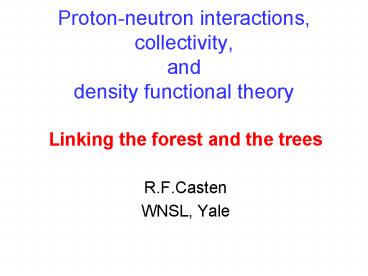Protonneutron interactions, collectivity, and density functional theory - PowerPoint PPT Presentation
1 / 28
Title:
Protonneutron interactions, collectivity, and density functional theory
Description:
Masses Physics. Shell structure: 100-300 keV. Quantum phase transitions: ~ 100 keV ... Fundamental symmetries 1 keV (e.g., unitarity of CKM matrix) ... – PowerPoint PPT presentation
Number of Views:34
Avg rating:3.0/5.0
Title: Protonneutron interactions, collectivity, and density functional theory
1
Proton-neutron interactions, collectivity, and
density functional theory
- Linking the forest and the trees
- R.F.Casten
- WNSL, Yale
2
Fundamental Questions for the Science of Nuclei
- What binds protons and neutrons into stable
nuclei and rare isotopes? - Complexity Microscopic Trees
- What is the origin of simple patterns in complex
nuclei? - Collective modes Macroscopic Forest
3
Valence Proton-Neutron Interaction
- Development of configuration mixing, collectivity
and deformation - Changes in single particle energies and magic
numbers - Partial history Goldhaber and de Shalit
(1953) Talmi (1962) Federman and Pittel ( late
1970s) Casten et al (1981) Heyde et al
(1980s) Nararewicz, Dobacewski et al (1980s)
Otsuka et al( 2000s) and many others.
4
Sn Magic no valence p-n interactions
Both valence protons and neutrons
5
Potentials involved In Phase transitions
Microscopic origins of phase transitional behavior
Valence pn interactions
Direct experimental evidence
6
Can we measure the valence p-n interaction? Empir
ical average p-n interaction of the last proton
and neutron - ?Vpn Double difference of
binding energies ?Vpn (Z,N) ¼ B(Z,N) -
B(Z, N-2) - B(Z-2, N) - B(Z-2, N-2)
This is a slight misnomer because there are two
contributions A real p-n interaction and a
smooth contribution from the symmetry energy
7
low j, high n high j, low n
Generic sequencing of shell model orbits
Hence, if the protons and neutrons are filling
similarly (similar fractional filling), the p-n
interaction should be largest.
8
Behavior of p-n interactions
9
First direct correlation of observed growth rates
of collectivity with empirical p-n interaction
strengths
10
Density Functional Theory
My understanding of DFT
Would you like to see it again? OK.
So, I hope all this is clear. Anyway,
Nazarewicz, Stoitsov and Satula calculated masses
for over 1000 nuclei across the nuclear chart
with several interactions, and, from these
masses, computed the p-n interactions using the
same double difference expression. Lots of
results. A few examples
11
Comparisons of DFT calculations with empirical
p-n interaction strengths
What works and what doesnt
12
(No Transcript)
13
Collaborators
Early work on this subject Jing-ye Zhang, Jerry
Garrett, Daeg Brenner
- R. Burcu Cakirli
- Daeg Brenner
- Eleanor Millman
- Witek Nazarewicz
- Mario Stoitsov
- Wojek Satula
Refs PRL, 94, 092501(2005) 96,
132501(2006) 98, 132502(2007)
14
Backups
15
(No Transcript)
16
(No Transcript)
17
(No Transcript)
18
Masses Physics
Total mass/binding energy Sum of all
interactions Mass differences Separation
energies shell structure, phase
transitions Double differences of masses
Interaction filters PRECISION REQUIRED
- Shell structure 100-300
keV - Quantum phase transitions 100 keV
- Interaction filters (e.g., p-n) 10-15 keV
- Fundamental symmetries lt 1 keV
- (e.g., unitarity of CKM matrix)
19
Different perspectives can yield different
insights
Onset of deformation as a phase transition and
change in shell structure
Onset of deformation
20
(No Transcript)
21
(No Transcript)
22
(No Transcript)
23
(No Transcript)
24
(No Transcript)
25
(No Transcript)
26
Nuclear collective motion individual nuclei
What is the origin of ordered motion of complex
nuclei? Complex systems often display
astonishing simplicities. Nuclei are no
exception. How is it that a heavy nucleus, with
hundreds of rapidly moving nucleons, can exhibit
collective motion.
27
(No Transcript)
28
This is a slight misnomer because there are two
contributions A real p-n interaction and a
smooth contribution from the symmetry energy
We will focus mostly on the former, which are
sensitive to the spatial overlaps of the proton
and neutron wave functions































